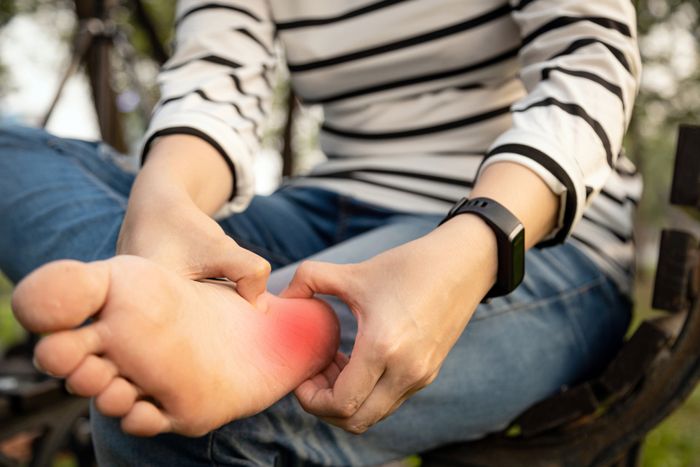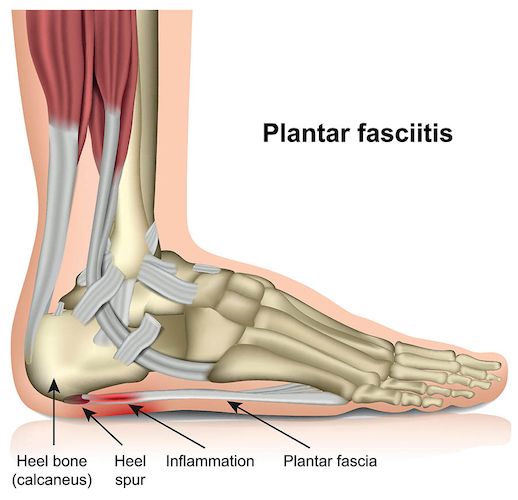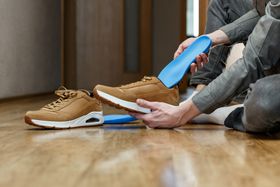Treatment Guide for Plantar Fasciitis
Updated January 30, 2024.

The plantar fascia is a thin casing of connective tissue below the skin, surrounding and covering the sole muscles. It extends from the origin of the heel of the foot to the base of the toes. It plays a vital role in the normal biomechanics of the foot, supporting the arch, and providing shock absorption.
What Is Plantar Fasciitis?
Plantar fasciitis happens due to the degeneration of collagen of the plantar fascia at its origin, the calcaneal tuberosity of the heel, and the surrounding structures. This is why the pain is located primarily at the heel, which is commonly worse in the morning or after long periods of walking and standing. This is due to the tenderness at the anteromedial heel. A limp may be evident with toe walking to take pressure off the heel.
Causes of Plantar Fasciitis
The cause of plantar fasciitis is mainly due to overuse and falls under the umbrella of "overuse injuries." In simple terms, this is due to repetitive strain on the foot leading to micro-tears of the plantar fascia. However, it can also be due to trauma or other causes such as:
- Obesity
- Use of the wrong shoes
- Impactful sporting activities like running, soccer, etc. that place stress on the foot with overuse
- Occupation involving long hours of standing and walking without rest
A sudden increase in activity levels is also the cause just before the onset of symptoms.
What Aggravates Plantar Fasciitis?
There are several aggravating factors like:
- Overactivity without adequate rest.
- Tight calf muscles that limit ankle mobility.
- Long periods of standing, walking, or running.
- Wearing high heels regularly as they put excessive strain on the foot and compromise its normal biomechanics.
- Flat feet or high arches accompanied by incorrect footwear.
- Excessive pronation (foot rolling inward while walking).
- Walking barefoot on a hard surface.
Treatments for Plantar Fasciitis
There are various treatments for plantar fasciitis. Post consultation with your healthcare practitioner, a home exercise program can be carried out. With your general practitioner and physiotherapist, make sure the diagnosis is correct depending on the history, clinical examination, and assessments to rule out any other differential diagnosis.
Patient education is the most critical aspect of any rehabilitation and injury management, following the dos and don'ts, the right way to carry out the exercise program, and wearing soft orthotics specifically designed for plantar fasciitis.
Most cases (around 90%) of plantar fasciitis are successfully managed and treated conservatively.
The Rest and Ice Method
Probably the most common treatment for plantar fasciitis, the rest and ice method can be performed by:
- Resting in between your daily activities and avoiding any aggravating activity of daily living that might increase the current pain levels.
- Icing the painful area for 7-10 minutes, three times a day, right from the initiation of pain in the acute phase. Ice massages can also be done by freezing a bottle of water and rolling it under your feet.
Deep Massage
Massaging the sole deeply also helps in releasing the tension and relaxing the fascia. Myofascial release from a qualified physiotherapist in the clinic also contributes to the recovery.
Stretching and Exercise
Exercises for the foot and lower limb are essential in recovering from plantar fasciitis. Mobility exercises for the ankle that include stretching and strengthening, along with electrotherapeutic modalities like ultrasound and transcutaneous electrical nerve stimulation (TENS), also play a significant role in healing plantar fasciitis.
Using Custom Orthotics to Treat Plantar Fasciitis
Orthopedic shoe inserts or orthotics (molded insoles for your shoes) are another form of assistive device prescribed in conjunction with the above conservative treatments to speed up the recovery process.
Custom-made orthotics, like Upstep's Plantar Fasciitis Custom Orthotics are highly beneficial in the treatment of plantar fasciitis. They help with pain and improving function by reducing the pressure and strain on the plantar fascia during standing, walking, and other activities of daily living. These orthotics also targets issues with the arches like flat feet, high arches, and pronation.
As every individual is different with different body biomechanics, it is imperative to have custom-made orthotics to assist and contribute to the speedy rehabilitation from plantar fasciitis in the right way.
It is ideally best to remove the shoe insole while wearing your custom-made orthotics and not to place custom-made orthotics on top of the shoe insoles as they work best when they rest securely on the shoe's interior.
» Ready to get started? Order a pair of Custom Orthotics for Plantar Fasciitis today
How Often Should You Wear Custom Orthotics?
Your body needs to get adjusted and used to wearing an external assistive device like foot orthotics; hence it is necessary to start by wearing for 4 to 6 hours a day, moving to 8 hours a day. It usually takes around 3 to 4 weeks to get used to the orthotics before you can start wearing them all day.
It is important to stop wearing orthotics entirely at the right time and not earlier before reaping the full benefits as weaning them off too early can further damage the feet, leading to serious health issues. Hence, wearing orthotics for at least 3 to 6 months is recommended before weaning them off completely post consultation with your healthcare practitioner.
Should You Wear Custom Orthotics Forever?
Wearing your custom-made foot inserts forever or not depends upon the level of dysfunction and faulty biomechanics of the foot posture. In cases of severe flat feet, high arches, and pronated feet that frequently lead to recurrent injuries, aches, and pains with functional limitations, there may be a need to use custom orthotics forever.
This is not only a treatment for plantar fasciitis but also a preventative measure for future injuries and pain.
It is vital to wear good custom-made orthotics, like Upstep, along with other conservative treatments of physical therapy and home exercise programs for plantar fasciitis to assist in complete rehabilitation and preventative measures.
» Still not convinced? Read more about the benefits of using custom orthotics for plantar fasciitis
Custom Made Orthotics for Plantar Fasciitis Improves the Quality of Your Life
Custom orthotics will make life with plantar fasciitis easier. Upstep creates plantar fasciitis custom orthotics that give you long-term pain relief for everyday activities, from work to sports. These orthotics cost 60% less than any other custom orthotic brand and are risk-free to try for 120 days.









